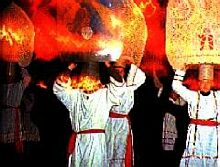|
|
|
CHRISTMAS
|
On December 5, which is the eve of St. Nichola´s Day, the tiny village of Kussnacht, located on the shores of Lake Lucerne, glows with the light of nearly two hundred enormous, transparent bishop´s miters worn by a group of men parading through the streets. The headpieces, some of them six feet tall, have been artistically designed, cut out of cardboard, assembled, and lit by a candle from within. Dressed in white robes, the people wearing these elaborate miters accompany St. Nicholas on his way through the village. The streets resound with the clang of heavy bells worn around the necks of muscular men, horn blowing, and the rhythm of a brass band. One can only wonder how the miter-wearing men manage to keep the wax from dripping down into their hair and how they prevent the cardboard hat from going up in flames.  The wide variety of customs in neighboring Swiss villages reflects the centuries of isolation the people endured during the winter months when the heavy snowfalls eliminated travel between mountain valleys. On December 6, the feast of St. Nicholas, school children in Glarnerland parade through the village, ringing and jingling bells of all sizes - sometimes in rhythmic unison and sometimes in wild abandon. The bells signal the villagers that a gift is expected from each household along the way. The gifts are usually some good things to eat or drink. While this bell ringing custom is not too unusual, it doesn´t begin to compare with the children´s parade in the town of Weinfelden. On the last Thursday before Christmas, the children in the town parade through the streets with their decorated fodder beets. These fodder beets have been hollowed out and lit from within with a beeswax candle. After singing carols in the town square, the children go to their schools where they dine on wurst and bread. At the same time, adults go the local tavern or coffeehouse, and the town council holds its annual budget meeting. Presumably, the thrifty Swiss eventually scrape the candle wax from the beets so they can be added to the animal troughs. In the village of Ziefen, several dozen young bachelors walk along a traditional route through the streets every Christmas Eve. The tallest bachelor, dons a white beard and leads the procession while carrying a sooty rag attached to the end of a long pole. Curiosity seekers leaning from their doorways and windows risk getting more than just an eyeful of the event. Quite a few onlookers end up scrubbing chimney soot from their faces. All the young bachelors wear oversized, long, dark coats and each wears a tall, black, top hat made of cardboard. Many of these hats are more then six feet high. The procession is relatively tame compared to the wild festivities it replaced from the early nineteenth century. Meanwhile, things are relatively quiet in the village of Hallwil where seven girls, 13 or 14-years-old, act out an ancient custom. A veiled Wienechtchind (Christmas child), dressed in white, and six companions in rose-colored garments, visit village families in the evening. The Wienechtchind greets the assembled household with a silent handshake and distributes cake or cookies to the children while the other girls sing a carol. The departure of this group is also silent. An ancient tradition in the town of Laupen, near Bern, is not only the opposite of Hallwil´s tradition - it´s totally absurd! New Year´s Eve is the time to be there if you want to see some outrageous shenanigans. The origins of the strange customs in Laupen can be traced back to the early nineteenth century. Originally the ceremonies took place on Christmas Eve and for years the town officials tried unsuccessfully to have them outlawed. Eventually the town priest managed to have the date changed to New Year´s Eve since it involved so much noise and rowdiness. After nightfall on December 31, the participating schoolboys, comprising three boisterous groups, meet on the hill at the local castle and proceed down to the village. In the first group are the "bell ringers", who swing or rattle large bells which can be heard for miles around. Next, the "broom men", carry long poles with bunches of juniper branches tied to the top. The third group is probably the most bizarre - the "bladder men" carry pig´s bladders filled with air. The procession stops at various locations along the route as the leader recites a rhymed farewell to the old year and wishes the crowd a happy new one. During the recitation, the broom men wave their juniper brooms over the heads of the crowd. At the end of journey, the broom men and the bladder men, all armed with inflated pig´s bladders, proceed to "beat" the onlookers, especially young ladies, until their weapons are in shreds. One must admit that it really takes a lot of guts to stand and watch this parade. These events in Switzerland, and many more like them, provide hours of entertainment for connoisseurs of folklore, however, before anyone tries to emulate these customs, you may want to check with local authorities before you swat someone with a pig´s bladder or a sooty rag. |
Please sign the Guest Book